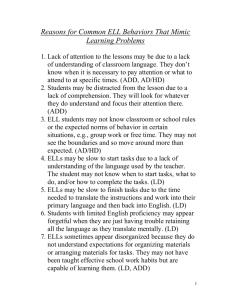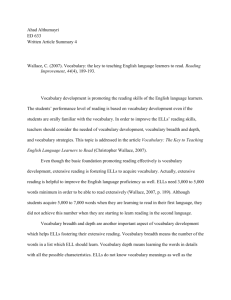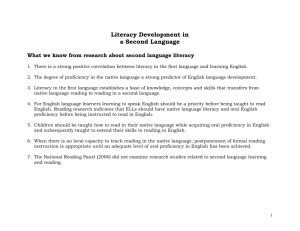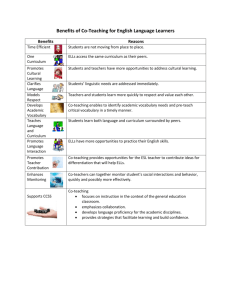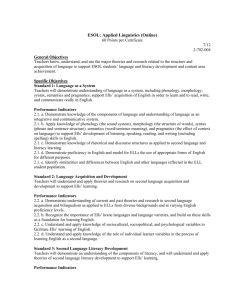Critical Features of Effective Programs for ELLs
advertisement
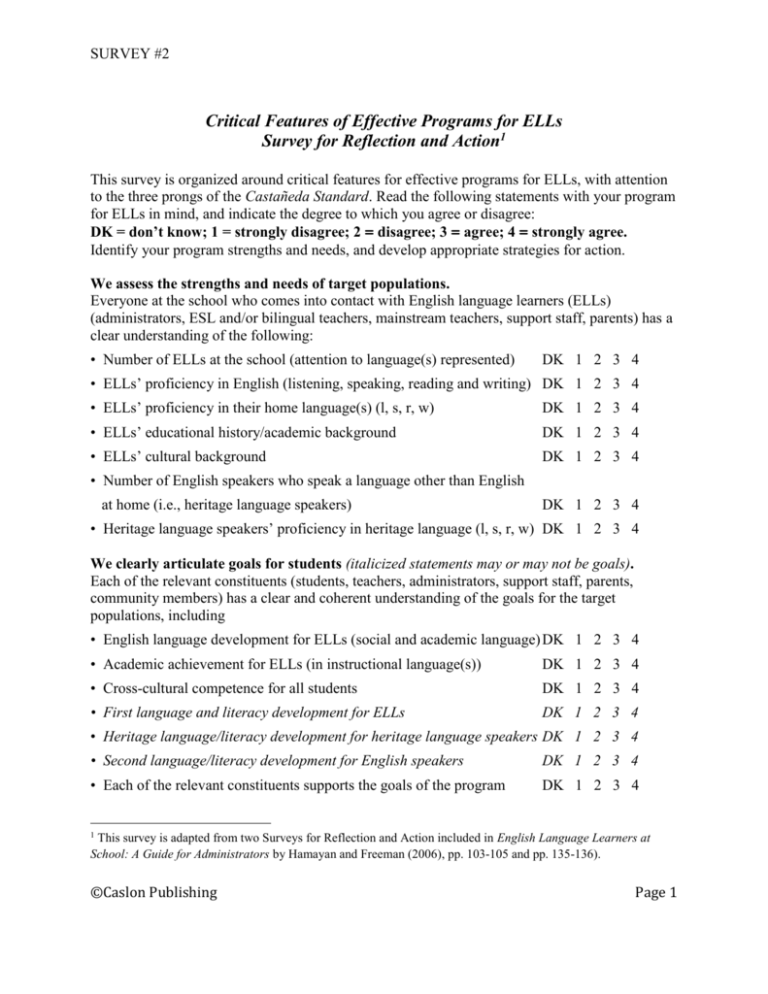
SURVEY #2 Critical Features of Effective Programs for ELLs Survey for Reflection and Action1 This survey is organized around critical features for effective programs for ELLs, with attention to the three prongs of the Castañeda Standard. Read the following statements with your program for ELLs in mind, and indicate the degree to which you agree or disagree: DK = don’t know; 1 = strongly disagree; 2 = disagree; 3 = agree; 4 = strongly agree. Identify your program strengths and needs, and develop appropriate strategies for action. We assess the strengths and needs of target populations. Everyone at the school who comes into contact with English language learners (ELLs) (administrators, ESL and/or bilingual teachers, mainstream teachers, support staff, parents) has a clear understanding of the following: • Number of ELLs at the school (attention to language(s) represented) DK 1 2 3 4 • ELLs’ proficiency in English (listening, speaking, reading and writing) DK 1 2 3 4 • ELLs’ proficiency in their home language(s) (l, s, r, w) DK 1 2 3 4 • ELLs’ educational history/academic background DK 1 2 3 4 • ELLs’ cultural background DK 1 2 3 4 • Number of English speakers who speak a language other than English at home (i.e., heritage language speakers) DK 1 2 3 4 • Heritage language speakers’ proficiency in heritage language (l, s, r, w) DK 1 2 3 4 We clearly articulate goals for students (italicized statements may or may not be goals). Each of the relevant constituents (students, teachers, administrators, support staff, parents, community members) has a clear and coherent understanding of the goals for the target populations, including • English language development for ELLs (social and academic language) DK 1 2 3 4 • Academic achievement for ELLs (in instructional language(s)) DK 1 2 3 4 • Cross-cultural competence for all students DK 1 2 3 4 • First language and literacy development for ELLs DK 1 2 3 4 • Heritage language/literacy development for heritage language speakers DK 1 2 3 4 • Second language/literacy development for English speakers DK 1 2 3 4 • Each of the relevant constituents supports the goals of the program DK 1 2 3 4 1 This survey is adapted from two Surveys for Reflection and Action included in English Language Learners at School: A Guide for Administrators by Hamayan and Freeman (2006), pp. 103-105 and pp. 135-136). ©Caslon Publishing Page 1 SURVEY #2 Our program for ELLs is based on sound educational and language learning theory. Specifically, the program includes the following critical features: • ELLs have access to comprehensible, standards- based instruction in all content areas (in their L1 or using sheltered English strategies) so they can achieve academically while they learn English. DK 1 2 3 4 • ELLs have access to regularly scheduled, standards-driven, content-based ESL instruction so that they can acquire the oral and written academic English they need to achieve in all content areas. • The program allows ELLs the time they need to reach all goals. DK 1 2 3 4 DK 1 2 3 4 • The program for ELLs is an enrichment program, not a remedial program; that is, ELLs’ native languages and cultures are seen as resources to be developed, not as problems to be overcome. DK 1 2 3 4 *For bilingual programs • There is a clearly articulated language plan that specifies how the two languages are to be used for instructional purposes. This plan is aligned with research on the bilingual education model implemented in that context (i.e., TWI, DBE, TBE). DK 1 2 3 4 • All of the constituents (students, educators, parents, community members) have a clear and coherent understanding of how the program is structured so that the target populations can reach their goals. DK 1 2 3 4 We understand that English language learners are everyone’s responsibility • Everyone who works with ELLs in our school (mainstream teachers, administrators, support staff, bilingual and ESL teachers, parents) understands their responsibility to the ELLs at our school, and shares in that responsibility. DK 1 2 3 4 • Teachers have opportunities to plan together and collaborate with each other on a regular basis so that they can effectively address their ELLs’ language, literacy and learning needs over time. ©Caslon Publishing DK 1 2 3 4 Page 2 SURVEY #2 We ensure that the program has adequate resources for implementation. The program for ELLs has the resources necessary for effective implementation, including • Appropriate curriculum in the language(s) used for instruction DK 1 2 3 4 • Appropriate materials in the language(s) used for instruction DK 1 2 3 4 • Qualified personnel with appropriate professional development; i.e., all educators (including mainstream administrators and teachers, literacy and special education specialists, counselors, staff) have the requisite knowledge and skills to address the needs of their ELLs. DK 1 2 3 4 • Valid and reliable formative and summative assessments of student performance and development relative to the goals of the program in the language(s) used for instruction DK 1 2 3 4 We use appropriate data to drive decision making. • ELLs are immediately identified and placed into appropriate programs based on valid and reliable assessment of their language, literacy, and learning strengths and needs. DK 1 2 3 4 • Valid and reliable data on student performance and development relative to all program goals are regularly collected. • Student performance data are used to inform instruction. DK 1 2 3 4 DK 1 2 3 4 • ELLs’ performance and development is monitored after they are redesignated as proficient in English. DK 1 2 3 4 • The program is regularly monitored and evaluated. DK 1 2 3 4 • We use valid and reliable summative and formative data to inform program and professional development. • The program delivers results. DK 1 2 3 4 DK 1 2 3 4 Program Development Strengths and Needs ______________________________________________________________________________ _____________________________________________________________________________ Action Steps ______________________________________________________________________________ ______________________________________________________________________________ ©Caslon Publishing Page 3


